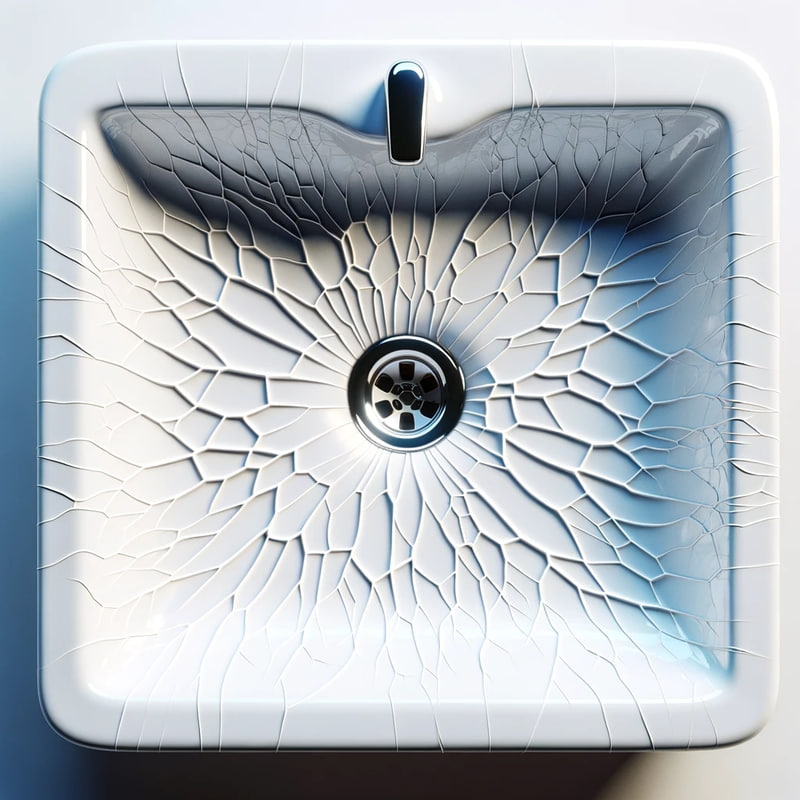A porcelain sink is a timeless addition to any kitchen, adding a touch of elegance and sophistication to the space. However, even the most durable porcelain sinks can develop cracks over time, due to factors such as sudden impact, stress, or extreme temperature changes. These cracks, if left unattended, can not only detract from the appearance of your sink but also pose a risk of leaks and water damage.
Fortunately, repairing cracks in porcelain sinks is a relatively straightforward process that can be done at home with the right tools and techniques. This comprehensive guide will provide you with all the information you need to restore your porcelain sink to its former glory.
Identifying Porcelain Sink Cracks
Before embarking on the repair process, it is crucial to correctly identify cracks in your porcelain sink. Cracks typically appear as fine lines that run across the surface of the sink. They may be hairline cracks, which are very thin and subtle, or they may be more visible, deeper cracks.
Assessing the Severity of the Crack
Once you have identified a crack, it is important to assess its severity to determine the appropriate repair method. Hairline cracks are typically easier to repair and may not require extensive preparation or filling. Deeper cracks, on the other hand, may require more careful attention and a stronger filler material.
Gathering the Necessary Tools and Materials
Before you begin, gather the necessary tools and materials for repairing the crack. These typically include:
- Porcelain repair kit: This kit will usually contain a filler, a sealant, and sometimes sandpaper.
- Epoxy glue: This two-part adhesive is ideal for repairing small cracks and chips.
- Porcelain or ceramic filler: This paste-like substance is designed to fill in larger cracks and chips.
- Scratch removal product: This paste or liquid is designed to remove scratches from the surface of the sink.
- Sandpaper: Medium-grit sandpaper (about 120-grit) is recommended for roughening the damaged area.
- Putty knife or spatula: These tools are used to apply the filler or epoxy glue.
- Toothpick: A toothpick is useful for applying epoxy glue to small cracks.
- Disposable gloves: Wear gloves to protect your hands from epoxy glue and other chemicals.
- Mask: Wear a mask to protect yourself from dust and fumes.
Preparing the Damaged Area
Proper preparation is essential for a successful repair. Follow these steps to prepare the damaged area:
-
Clean the sink: Use an all-purpose cleaner to remove any dirt, grime, or grease from the cracked area. Rinse thoroughly with clean water.
-
Dry the sink: Allow the sink to air dry completely.
-
Sand the area: Use medium-grit sandpaper to roughen the surface of the cracked area. This will help the filler or epoxy glue adhere to the sink’s surface.
Applying the Filler or Epoxy Glue
After preparing the damaged area, you can apply the filler or epoxy glue. The specific method will depend on the type of crack and the material you are using:
For hairline cracks:
- Mix the two parts of the epoxy glue together according to the manufacturer’s instructions.
- Use a toothpick to apply the epoxy glue to the crack.
- Let the epoxy glue dry completely.
For larger cracks:
- Apply porcelain or ceramic filler to the cracked area using a putty knife or spatula.
- Spread the filler evenly, ensuring it fills the entire crack.
- Let the filler dry completely according to the manufacturer’s instructions.
Sealing the Repair
Once the filler or epoxy glue has dried completely, you need to seal the repair to prevent water from seeping into the damaged area and causing further damage.
- Apply a high-quality porcelain or ceramic sealant to the repaired area using a putty knife or spatula.
- Spread the sealant evenly, ensuring it covers the entire repaired area.
- Let the sealant dry completely according to the manufacturer’s instructions.
Quick Repair Job
If you need to repair a crack quickly, you can do a quick repair job. This involves using a porcelain repair kit that includes a quick-drying filler. Simply apply the filler to the damaged area and let it dry for a few minutes. Once the filler is dry, you can use the sink as usual. However, a quick repair job is not as durable as a full repair, and it may not last as long.
When to Replace Your Sink
If the crack is too deep or if the damaged area is too large, you may need to replace your sink. You should also replace your sink if it is leaking.
Preventing Future Cracks
To prevent future cracks from developing in your porcelain sink, follow these tips:
-
Avoid sudden impact: Do not drop heavy objects into the sink or hit it with hard objects.
-
Avoid extreme temperature changes: Do not pour boiling water directly into the sink, and avoid sudden temperature changes between hot and cold water.
-
Use a sink grid: A sink grid will protect the surface of your sink from scratches and impact.
-
Use mild cleaning agents: Avoid using harsh cleaning agents that can damage the porcelain finish.
-
Rinse the sink thoroughly: After using the sink, rinse it thoroughly with clean water to remove any dirt or debris that could cause scratches.
-
Regularly inspect the sink: Inspect your sink regularly for any signs of cracks or chips.
Additional Tips for Repairing Porcelain Sink Cracks
-
Always follow the manufacturer’s instructions when using a repair kit.
-
Work in a well-ventilated area.
-
If you are unsure about how to repair a crack, consult a professional.
Cost of Porcelain Sink Crack Repair
In London, the cost of porcelain sink crack repair can vary greatly. It typically depends on the severity of the crack and the specific repair service selected. However, residents can generally expect to pay anywhere between £100 to £300 for professional crack repair services.
Can you repair cracked porcelain?
Yes, you can repair cracks in porcelain sinks. The severity of the crack will determine the best repair method. Hairline cracks can be repaired with epoxy glue, while larger cracks may require porcelain or ceramic filler. Sealing the repair will prevent water from seeping into the damaged area and causing further damage.
How do you make a porcelain sink look new again?
To make a porcelain sink look new again, you can clean it with an all-purpose cleaner and then polish it with a soft cloth. If the sink has scratches, you can use a scratch removal product. For deeper scratches, you may need to use a porcelain or ceramic filler.
How do you fix the enamel on a porcelain sink?
If the enamel on your porcelain sink is chipped or scratched, you can repair it with a porcelain repair kit. The kit will typically include a filler, a sealant, and sandpaper. Follow the manufacturer’s instructions to apply the filler and sealant.
Will super glue fix broken porcelain?
Super glue can be used to repair small cracks in porcelain, but it is not as durable as epoxy glue. Epoxy glue is a two-part adhesive that is very strong and durable. It is ideal for repairing small cracks and chips in porcelain sinks.
How do you touch up a chipped porcelain sink?
To touch up a chipped porcelain sink, you can use a porcelain repair kit. The kit will typically include a filler, a sealant, and sandpaper. Follow the manufacturer’s instructions to apply the filler and sealant.
Can you repair cracks in a porcelain sink?
Yes, you can repair cracks in a porcelain sink. The severity of the crack will determine the best repair method. Hairline cracks can be repaired with epoxy glue, while larger cracks may require porcelain or ceramic filler. Sealing the repair will prevent water from seeping into the damaged area and causing further damage.
Can a porcelain sink be restored?
Yes, a porcelain sink can be restored to its original condition or at least to a state where it is visually appealing and can be used without issues. The severity of the damage will determine the restoration process. Small cracks, chips, and scratches can be repaired using a porcelain repair kit. For larger cracks or damage that exposes the underlayer, professional restoration may be necessary.
Can you seal a porcelain sink?
Yes, you can seal a porcelain sink to protect it from further damage and enhance its appearance. Sealing a porcelain sink involves applying a sealant to the entire surface of the sink. This will create a protective barrier that will prevent water from seeping into the pores of the porcelain and causing damage. It will also help to prevent scratches and chips from forming.
How do you fix a hairline crack in a porcelain sink?
To fix a hairline crack in a porcelain sink, you can use epoxy glue. Epoxy glue is a two-part adhesive that is very strong and durable. It is ideal for repairing small cracks and chips in porcelain sinks. To use epoxy glue, mix the two parts together according to the manufacturer’s instructions. Then, apply the epoxy glue to the crack using a toothpick or applicator. Let the epoxy glue dry completely.
Conclusion
Repairing cracks in porcelain sinks is a relatively simple process that can be done at home with the right tools and techniques. By following the tips in this comprehensive guide, you can restore your porcelain sink to its former glory and save yourself the cost of a new sink. Remember, it is always best to consult with a professional if you are unsure about how to repair a crack.


